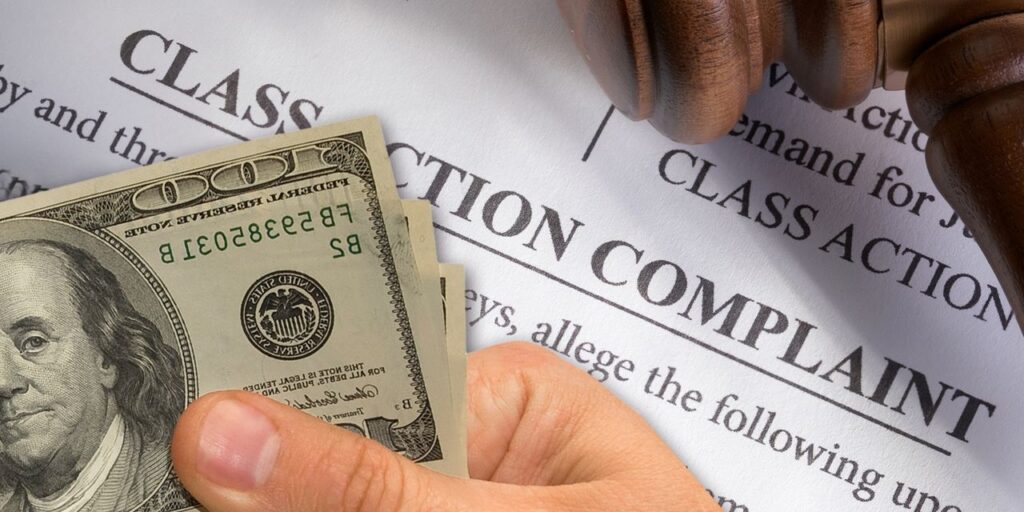Trust me, I speak from experience. Just last year I cashed a check for $274.03 from another settlement.
In this case, it was a class-action lawsuit against Noom, the weight-loss program I had signed up for some years ago. The suit charged that the company’s “autorenewal and cancellation practices violated both common law and consumer protection laws nationwide,” according to the settlement website. Noom denied the allegations, but settled the suit for $56 million, with the company saying that it believed “the settlement is the best path forward as it allows us to focus our energy on delivering the best possible health outcomes for our Noomers.”
I can barely recall filling out the lawsuit form, so the check was a welcome surprise. And in a sense, I wasn’t really “profiting” — class-action suits are about righting wrongs — but this was still money I didn’t expect to have. And it came just in time for the holiday-shopping season.
Sure enough, this isn’t the first instance I’ve received such a settlement check. I usually respond any time that I’m contacted about a class-action suit, even though it may take a while before I receive the money. And, to be sure, the figure is often a nominal amount — the Google settlement website states “each claimant is estimated to receive approximately $7.70 if they file an Approved Claim” — or the settlement provides an offer of goods and services instead of cash. (Scroll down for what steps to take to claim that cash.) But again, I look at it as an unexpected “gift,” the legal equivalent of stumbling upon a $20 bill on the street.
As it turns out, there’s a community of people who take these things to the next level. Not only do they respond when they are contacted about suits, but they also look for other suits that they may be eligible for.
Consider Philadelphia resident Noah Webster (yes, he says he’s distantly related to the dictionary editor). He says he typically takes in more than $1,000 each year by keeping on top of the suits he can join. Like me, he got nearly $300 from the Noom case, but he’s also received money through settlements with companies and brands ranging from cellphone-service providers to Naked Juice.
““It has the benefit of keeping companies honest.””
Webster told me that consumers should never feel like they’re beating the system or playing some kind of game when they join a suit. For him, the cash is nice, but the cases are really about holding businesses accountable. “They’re the ones using the system against consumers” in the first place, he says.
Either way, if you’re hoping to earn some settlement money, there are a few things worth understanding. Or, as Webster says, “So many friends are messaging me and asking me, ‘How do you do this?’”
Here are five key tips…
First, you need to be in the know.
Information is king, as they say. You may learn about a class-action lawsuit by hearing or reading about it in the news — and the Google case has certainly been discussed widely.
But often the easiest way to know about any class-action lawsuit is by being contacted directly from a suit administrator, often via a postcard mailing. (And if there’s any question as to whether the contact is legitimate, you can always look up the case online and even reach out to the law firm representing the plaintiffs, legal experts advise.) Still, you may not necessarily be in the contact loop — that is, there may not be a record of your purchase of a product or service (that’s especially true with smaller purchases) or you may have moved since you made the purchase.
At the very least, if it’s an option, you should register every product purchased with the company so that your contact information at that time is in the system. “Spend that 60 seconds,” says Scott Hardy, president of Top Class Actions, a website that provides information about suits. A side benefit to registering, Hardy notes: You’ll be made aware of any product recalls.
But what if you’re not in the contact loop? That’s why it pays — literally — to learn about what suits are in motion. Top Class Actions is one source for such information, but there are others, such as ClassAction.org and Consumer Action.
Decide if you want to opt in, or take action yourself.
Even if you have a legitimate claim, you may not want to join the suit. That’s because you may feel that you have a strong enough individual claim to merit a case of your own. Experts advise that you can always discuss the matter with an attorney to help weigh the merits of joining versus not joining. Hardy says that reaching out to the law firm representing the plaintiffs to discuss the matter is also a possibility. But he warns that opting out rarely works in your favor.
Do the paperwork.
Sometimes, joining a suit may take just a few minutes of your time, such as is case the Google one. “It could be a matter of saying, ‘I bought this product on this date’ and that’s it,” Hardy says. Other times, you may be asked to provide more documentation, but experts advise that could be key to getting a bigger settlement. Webster says he had records of all his Naked Juice purchases — he typically bought the product at Starbucks and saved his receipts — and that got him a larger check. (The Naked Juice case involved a claim about its “all natural” labeling; PepsiCo
PEP,
the company behind the brand, agreed to a $9 million settlement.)
Be patient.
Forget about getting a check in 30 days from the time you respond. You’re looking at months, if not years. Philip D. Stern, an attorney who specializes in class-action suits and is with the New Jersey-based Kim Law Firm LLC, says the court process involves hearings, potential objections and working out a final settlement, all of which takes time. But Webster says that if you’re regularly joining suits, then the time lag is less of an issue — ideally, while you’re waiting for one suit to get settled, you’re receiving a check from another.
Keep your financial expectations in check.
While Stern says he has seen settlements that can go as high as thousands of dollars per person, he has also seen ones for as little as a few pennies. A lot of it depends on how many people respond — as in, the more who join a suit, the less each person gets. That said, Stern notes that usually fewer than 20% of those who are eligible to join do so, which means a lot of people are leaving money on the table. Think of it a bit like playing the lottery — you’ve got to be in it to win it. But again, your “victory” may be about something larger. “It has the benefit of keeping companies honest,” Stern says.
How to get money in the Google settlement, in particular
To get your hands on your $7.70 piece of the $23 million Google settlement, visit the claim website here to make sure that you qualify, and register at this link to get a class member ID number. (Pro tip: Make sure to check your email junk folder for correspondence from the Google settlement site.) You’ll then need to submit an online claim here, which should only take a few minutes. You’ll be asked for contact information, including your physical mailing address and email, and then you must declare that you looked something up via Google search and clicked on a resulting search link between Oct. 25, 2006 and Sept. 30, 2013. Finally, you’ll pick your payment method: PayPal, Venmo or a prepaid card.
Read the full article here













